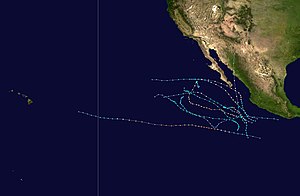| 1995 Pacific hurricane season | |
|---|---|
 Season summary map | |
| Seasonal boundaries | |
| First system formed | May 21, 1995 |
| Last system dissipated | September 26, 1995 |
| Strongest storm | |
| Name | Juliette |
| • Maximum winds | 150 mph (240 km/h) (1-minute sustained) |
| • Lowest pressure | 930 mbar (hPa; 27.46 inHg) |
| Seasonal statistics | |
| Total depressions | 11 |
| Total storms | 10 |
| Hurricanes | 7 |
| Major hurricanes (Cat. 3+) | 3 |
| Total fatalities | 124 total |
| Total damage | $31 million (1995 USD) |
| Related articles | |
The 1995 Pacific hurricane season was the least active Pacific hurricane season since 1979,[1] and marked the beginning of a multi-decade period of low activity in the basin. Of the eleven tropical cyclones that formed during the season, four affected land, with the most notable storm of the season being Hurricane Ismael, which killed at least 116 people in Mexico. The strongest hurricane in the season was Hurricane Juliette, which reached peak winds of 150 mph (240 km/h), but did not significantly affect land. Hurricane Adolph was an early-season Category 4 hurricane. Hurricane Henriette brushed the Baja California Peninsula in early September.
The season officially started on May 15, 1995, in the Eastern Pacific, and on June 1, 1995, in the Central Pacific, and lasted until November 30, 1995.[2] These dates conventionally delimit the period of each year when most tropical cyclones form in the northeastern Pacific Ocean. The season saw eleven tropical cyclones form, of which ten became tropical storms. Seven of these storms attained hurricane status, three of them becoming major hurricanes. There were fewer tropical storms than the average of 16, while the number of hurricanes and major hurricanes were slightly below average.[3]
- ^ National Hurricane Center; Hurricane Research Division; Central Pacific Hurricane Center (April 26, 2024). "The Northeast and North Central Pacific hurricane database 1949–2023". United States National Oceanic and Atmospheric Administration's National Weather Service. Archived from the original on May 29, 2024. A guide on how to read the database is available here.
 This article incorporates text from this source, which is in the public domain.
This article incorporates text from this source, which is in the public domain.
- ^ Dorst, Neal. "When is hurricane season?". Atlantic Oceanographic and Meteorological Laboratory. Archived from the original on December 6, 2010. Retrieved November 25, 2010.
- ^ "Average Cumulative Number of Systems Per Year". National Hurricane Center. 2005-08-17. Archived from the original on 2012-10-18. Retrieved 2010-04-12.